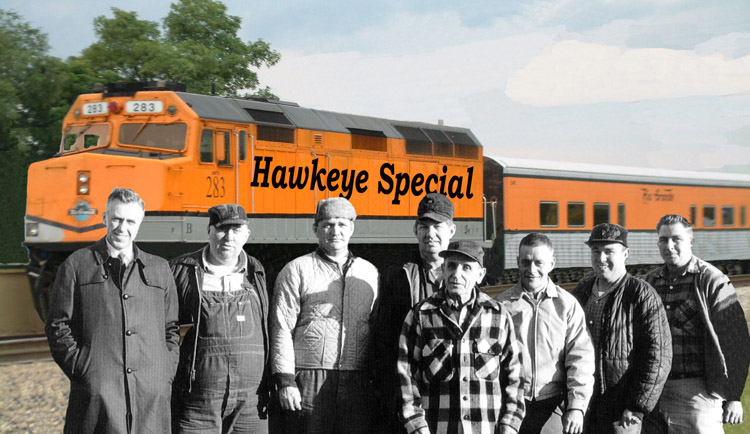
A
1950s image of Rock Island men who helped route special trains to Kinnick
Stadium is superimposed upon a photo of
a train currently reviving the effort. The collage created by the author displays altered labeling on the engine.
By Bob
Hibbs
|
As
with many revivals, however, it’s not quite what it used to be. As
many as 10 specials dropped scores of people at Kinnick during the late
1940s, recalls Chet Miller who worked in the Rock Island Railroad yards
after graduation from Iowa City High in 1945 before going to work for
the U.S. Postal Service. He recalls that the larger gatherings were for
the Notre Dame and Minnesota games. The
trains ranged in size from four or five cars each, up to a maximum of 10
or 12 from Des Moines, Miller says.
Most cars typically were not packed full, carrying from 40 to 50
people in the coaches, but only 20 to 25 in the Pullman sleeper cars
routed from as far away as South Bend, Ind. On
the Rock Island, trains came from both directions, often originating as
far east as Chicago and Omaha in the west, stopping at stations along
the route to pick up anyone who had scheduled the ride. Minnesota fans
probably would have been routed to Cedar Rapids, then into Iowa City
over the Crandic route. There
were two sets of tracks beside Kinnick during that era, while only one
set remains today – and it’s now in use as the main line across
Iowa. Incoming trains were timed to avoid each other as much as
possible, but sometimes had to wait in the Iowa City yards a few minutes
until space was opened on the Kinnick siding. The
author recalls seeing fans streaming up from the tracks below the
Melrose Avenue overpass at Kinnick during the 1960s. Wooden stairs there
have been repaired to serve current patrons; but, in no where near the
size used earlier. During
the time of a game, crews took the equipment to the Iowa City rail yards
east of the still existing depot on what is now the Iowa Interstate
Railroad, the successor to Rock Island in the state. There
was plenty of partying during the train rides; in fact, so much so that
Miller recalls some men were in no condition to attend a game, so
sometimes would just remain on their train to avoid getting lost or
being left after the game. Ginny
Bireline Herbert recalls her father telling her that when he worked the
specials he frequently was invited to join parties at the stadium –
and often accepted the invitations. An Oxford native from about 1900 who
loved railroad work, he was particularly eager for the Saturday work,
she relates, since it meant pay at overtime rates. She
recently provided an image of her father and seven other Rock Island men
taken in front of a white shed in the rail yards at Iowa City. The
author superimposed the men from that image upon a photograph of the
current “Ski Train” being used to transport fans from near Coral
Ridge Mall to Kinnick for home games this season to help mark the 75th
anniversary of the construction of Kinnick in 1929. The labeling on the
train also was altered by the author. The
Ski Train is on assignment here this fall from its usual winter duty of
serving patrons in the Colorado Rockies. She
identifies the men in the picture, from left, as Webb Cramer, Dale Cox,
Charles McConnell, Bob Schafer, Cyril Bireline, Bill Schindale, Paul
Noah and Harold Shipley. Her father and McConnell are known to be
deceased; the whereabouts of the others is unknown. Although
these 1950s men are shown here now half a century later, as just a
phantom image, the train is real. Next
Saturday: Iowa City Rec
Center marks 40 years. Bob
Hibbs collects local postcards and other historic ephemera and
researches history related to them. |